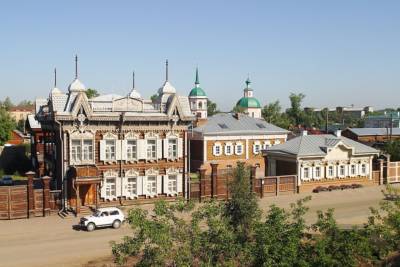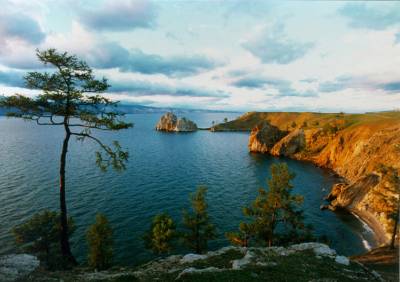Discover Irkutsk and Baikal
Irkutsk
The Eastern Siberian city of Irkutsk is one of the oldest and most attractive Siberian cities. It has a long and eventful history which reflects fully the history of Siberia. Siberia (meaning Sleeping Land) is a vast territory of this Russia.
Irkutsk began as a Cossack settlement in 1661. A new trading outpost was built near the confluence of two rivers, the Angara and the Irkut. The name of the city originates from the name of the river Irkut (meaning Fast Flowing River), which came from the language of native Siberians belonging to Mongolian ethnic clan. In the past, Irkutsk was a consumer city which had to import many products from other areas. It was not until the end of the 19th century that great industries began to develop. The first industrial enterprise in Irkutsk was a brick factory. Prior to it commencing operation, Irkutsk had been a town of log structures. The great fire of Irkutsk in 1879 destroyed nearly 80% of the central area of Irkutsk. The town was rebuilt quickly and its recovery was aided by the construction of the TSR and especially by the completion of the link around Lake Baikal in 1905.
The main sightseeing structures of the city are:
The church of Our Saviour, which is considered to be the oldest stone structure in Irkutsk, the building of the Regional Administration (locally called the Grey House), and the War Memorial opened in 1975, when the country celebrated the 30th anniversary of the victory in the 2nd World War. Epiphany Cathedral was the third stone structure in Irkutsk built in the same style as the Church of Our Saviour. Also the Roman Catholic Church which is locally called the Polish Cathedral in Kirov Square (the central square of Irkutsk). Once called Tikhvinskaya, it was renamed in 1935 after S.Kirov, one of the Soviet leaders and revolutionaries who in the beginning of the 20th century illegally lived in Irkutsk in order to revive the Party here. Znamensky Cathedral, (or the Cathedral of the Omen) was founded in 1683 as a nunnery to glorify the apparition of our lady. The stone church was built in 1762. The Russian word Znamenye, which gave the cathedral its name, corresponds to the English Omen and comes from the name of the most respected icon of the cathedral. The monument to Alexander III was built to commemorate the coming of the first train to Irkutsk in 1898. The construction started during the rule of Alexander III, and he thus became the patron of the construction of wooden houses.
Amazing pictures of Irkutsk by famous Irkutsk art photographer Alexandre Kniazev
 Baikal Lake
Baikal Lake
There is no such a glorified lake in the world as Lake Baikal. It can’t be repeated and it is so fantastic, and all other Russian lakes seem in comparison with it small and fleet. The enormous size and depth of this lake, a surprising clearness and transparency of its emerald-green waters, severe beauty of the shores make an unforgettable impression. And if to ask experienced travelers to name three finest places of Russia, all of them will name among other Lake Baikal.
The Russian Cossacks-pathfinders who have seen it in the XVII century for the first time named this lake "The Big Ocean-Sea ". However, the Cossack Pentecostal Kurbat Ivanov who led his detachment to the Baikal shore in 1643 wasn't the pioneer of Baikal. Before the Russian arrival there lived the different peoples for many centuries. And all of them gave to huge reservoir majestic names. Mongols, for example, named it Dalai Nor - "Great lake", and Evenki – “the Lama” that means "The Sea". And now inhabitants of coastal settlements, speaking about Baikal, usually call it “the sea”. There is no wonder in it: the length of a huge reservoir - six hundred forty kilometers (it is a bit less, than from Moscow to Petersburg), and width in the middle part reaches eighty kilometers! The area of Baikal (31500 sq. km) takes the eighth place in the world among lakes and is approximately equal to the area of such country, as Belgium.
There are no lakes deeper than Baikal on continents of our planet: underwater echo sounder metered 1637 meters to the east from island Olkhon in 1974. The bottom of the Baikal cavity is 1200 meters below the ocean level and it is the lowest place on the whole land of the globe. The lake cavity contains the fifth part of all fresh water on the Earth (23000 cubic km). To take it out in the sea, all the rivers of the planet should work for eight months! In volume of water Baikal almost a hundred times surpasses the sea of Azov and in thirty times the Aral sea. Besides, Baikal is the purest on the Earth natural storehouse of fresh potable water. There are no open reservoirs with fresh water suitable for drinking in the world. Baikal is the only exception, whose waters possess exclusively high flavoring qualities.
The climate of the lake and its shores has much in common with the sea. Huge water mass of Baikal during the hot summer period gets warm to depth of 200-250 meters, but because of strong winds the water in it constantly mixes up, and its top layers haven't got enough time to get warm. Therefore, even in July water temperature in the lake is about ten degrees, and tempered people bathe in it only. The huge lake considerably influences surrounding territory: in the summer it is five-six degrees more cool, and in the winter about ten degrees warmer, than far from Baikal, for example, in Irkutsk. That’s why the lake becomes covered by ice only in the end of December, and the unique river outflowing it - fast and wide Angara - throughout the duration of first thirty kilometers doesn't freeze at all.
The specific meteorological conditions are typical for Baikal. The winds on the lake are not the same as in the other places on the earth: struggling out of gorges suddenly they bring a lot of disasters. Each wind has its own local name usually associated with the valley of the river, where it is formed, for example: barguzin, kultuk, verkhovka, losk, sarma, nik, khius, siver and so on. The most furious of them are barguzin and sarma that blusters in autumn and in winter in the Small Sea just in front of Olkhonskiye Vorota (Olkhon Gates). Sarma, falling from mountains in narrow space of the Small Sea, reaches storm force, breaks crests of waves, forming tornadoes, lifts clouds of splashes which quickly freeze in the air, winds and a roar of waves can be so strong that they muffle a shot sound. The waters of Baikal boil spitefully and furiously: at times it seems that tops of waves reach black, low clouds. Rocks shudder from blows of waves and buzz ominously. Only the brush of the artist or symphonic music can transfer the majestic and terrible beauty of these storms.
There are some natural corners in Russia which conquer at once and for ever. One doesn’t need to be a zoologist or a geologist to believe in uniqueness of Baikal. It is enough to be able to see and compare, and then any traveler, who though one time visited "the nice sea", as sure as fate will estimate justice and accuracy of an ancient proverb: "Who didn't see Baikal - that didn't use to know Siberia..."
Amazing pictures of Baikal by famous Irkutsk art photographer Alexandre Kniazev






